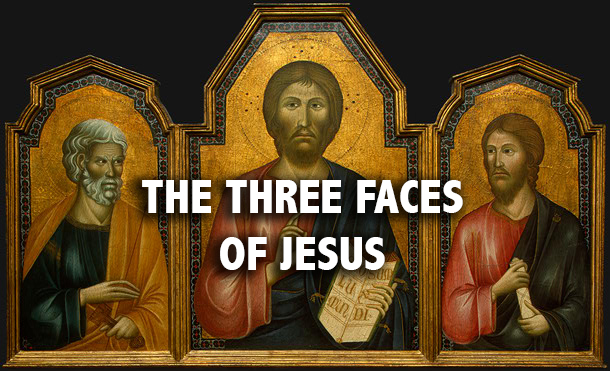The Three Faces of Jesus
Jesus of Nazareth remains one of the most enigmatic figures who’s ever lived. Millions of Christians, perhaps billions, believe he was God incarnate. More than a billion Muslims believe he was not divine, but a prophet. In contrast, there are a growing number of skeptics that doubt he even existed e.g., Tom Harpur, seeing in him a composite figure of older “pagan” deities.
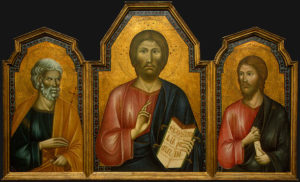
For his part, the Jesus that appears in the gospels is hard to pin down theologically or historically. He seems to speak in code, parables and metaphors. When he’s asked if he considers himself a king, he answers: “You say that I am.” (John 18:37). He then asks his disciples who they think he is and when they say “Messiah”, he doesn’t confirm nor deny, but blesses (Matthew 16:13-20). Other times he’s talking about “mustard seeds” (Matthew 17:20), “weeds” (Matthew 13:24) and “figs” (Luke 13:6-9) – hardly the stuff that makes history clear.
The search for the “historical Jesus” was also encumbered by the violence of the Church. For millennia, you couldn’t discuss Jesus freely (similar to the situation with Muhammad today). For example, in the 5th century in Alexandria, Egypt, Hypatia was one of the great figures of the times. She was beautiful and well versed in astronomy, music, mathematics and philosophy. When she stood up to the Christian Patriarch, Cyril, in March of 415 CE/AD, the Christians of the city pulled her from her chariot, took her to a Church, stripped her of her clothing and then stripped her of her skin with broken bits of pottery. They then dragged her corpse outside the city walls and burned it. Cyril, who instigated all this, was eventually made a saint. This was hardly an atmosphere conducive to a free and open debate about the historical Jesus.
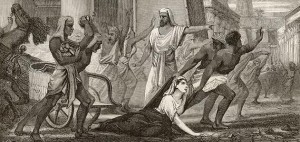
Censorship, dogma and intimidation was the order of the day until very recently. Over the past few centuries, especially in the last 50 years, more and more access is becoming available to the historical Jesus and his time. Beginning with the Protestant Reformation, there was a tendency among Christians to seek out the historical Jesus. But this gained momentum with the advent of archeology in the late 1800’s and the birth of modern Israel in 1948, especially with the Six-Day War in 1967, when old Jerusalem became part of the Jewish state. Suddenly, there was a convergence of interest in the historical Jesus and access to archeology that had previously been inaccessible. Meaning, in the last few decades, we suddenly have a way to access Jesus without fear of the Inquisition and with data that was previously unknown. So what do we know?

Basically, three models of Jesus have emerged in the last few years. First of all, scholars generally agree that there was indeed an individual called Jesus, Joshua in Hebrew, who lived in the first part of the 1st century in ancient Judea. It is also generally agreed that he started his public career in the Galilee and, in short order, he was crucified by the Roman authorities of the time. But what did he stand for? What was the true face of Jesus?
Face one. According to this view, the traditional Christian story is historically accurate. Scholars use fancy terms such as “Early Christology” to say this. What they mean by this is that, very early on, Jesus’ followers believed that he was the “Christ” i.e., the Messiah. More than this, they believe that very early on Jesus declared himself to be “divine” and his followers understood him to be divine. This is the view that Paul espoused shortly after the crucifixion and it’s the view that became the “orthodox” Christian teaching. Scholars who hold on to Paul’s view of Jesus e.g., Larry Hurtado, argue that Paul is the best “witness” to what Jesus really believed. They generally state that all archeology that contradicts this view is either later than Jesus, earlier than Jesus or a fake. According to this view, Jesus broke with the Jewish people. They didn’t understand him. He had a new message that was embraced by a small group of Jewish followers, but really took off when his “gospel”, or “good news”, was embraced by gentiles. In this sense, Jesus was the first “Christian”.
Face two. According to this view, the deification of Jesus is late – not early – and has nothing to do with Jesus or his original circle of followers. Generally, scholars in this camp look to Jesus’ brother, James, a Jew we would describe as “orthodox” today, to find a more authentic version of Jesus. The leader of this camp is Prof. Robert Eisenman. Eisenman’s view is; “as with James, so with Jesus.” In other words, Jesus was a mainstream kosher Jew, followed Jewish law and didn’t claim to be divine. Others in this camp include S.G.F Brandon who saw Jesus as an anti-Roman Jewish insurrectionist, a member of the 1st century revolutionary group called the “Zealots”. Reza Aslan, who scored a bestseller with his “Zealot: The Life and Times of Jesus of Nazareth” when he recycled Brandon’s theory, also belongs to this camp. This face of Jesus is one of a “super Jew”, a man of his people who paid with his life for his patriotism. According to this view, “Christianity” was a later fabrication. Put differently, Jesus had no idea that he was a Christian. He lived and died a Jew.
Face three. In the Christian tradition, this view of Jesus is best represented by a mysterious figure vilified by the Church. Usually, if someone is really trashed by the Church we can assume that he was historically significant. The man I’m talking about is known as “Simon Magus” i.e., “Simon the Sorcerer”. Simon lived at the same time as Jesus, Peter and Paul. After the crucifixion, he claimed to be Jesus incarnate. The Church countered that he was a cheap magician and explained his numerous “miracles” as nothing more than trickery. According to Acts 8:9-24, Simon saw the apostle Peter as a fellow sorcerer or magician. Wanting to enhance his magical repertoire, Simon offered money for the secrets behind Peter’s healing miracles. In fact, the word “Simony” i.e., the corrupt practice of selling church privileges, is named after Simon Magus. But if we look beyond the insults, what do we see? We see a man of mixed parentage (as both Pagan and Jewish sources say Jesus was), who was married (as Gnosticism, an early Christian tradition, claims for Jesus) and who engaged in miracle working as a form of magic.
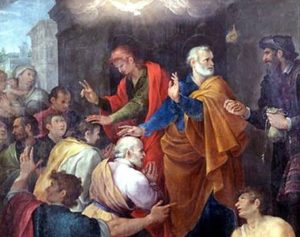
This view of Jesus as a magician was espoused by Prof. Morton Smith and is reinforced by the discovery of “heretical” gospels in Nag Hammadi, Egypt, 1947. According to this view, Jesus was neither a kosher Jew nor an outright Pagan. Rather, he and his followers preached a “syncretic” i.e., a “fusion” of Jewish and non-Jewish practices, including the idea of sacred sexuality as a way of linking the carnal and the spiritual. Most people were first exposed to this theory when reading the fictional bestseller “The Da Vinci Code”, or seeing the Ron Howard’s blockbuster movie of the same name. The popularity of this view makes it the butt of scholarly jokes, but Gnosticism is very real and Simon Magus was an actual historical figure. Historically speaking, he’s as real as Jesus. One could easily say; “as with Simon, so with Jesus”.
So for all those confused by all the theological and scholarly jargon, here is where things stand in the search for the historical Jesus: there is Paul’s version of Jesus, James’ version of Jesus and Simon’s version of Jesus. The latest archeology – as documented in my documentary and co-written book – seems to support Simon.
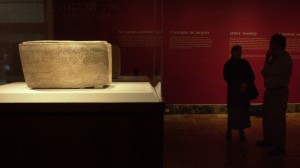
See my latest blog in the Times of Israel: Scarlett Johansson – My Hero!
